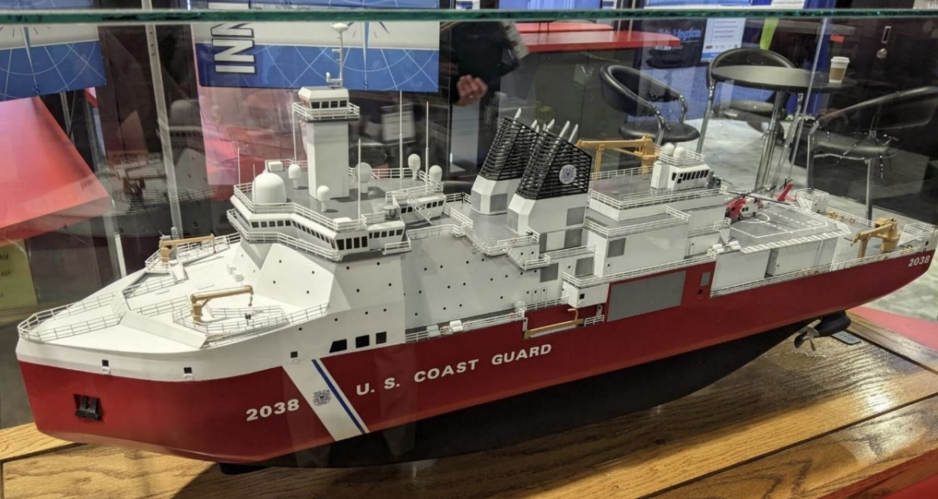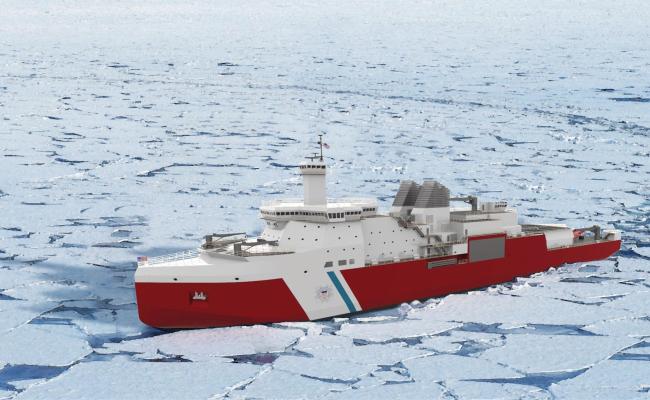U.S. Polar Icebreaker Faces New Delays and Cost Overruns Report Says

Photograph of a PSC model displayed at 2021 trade show. (Source: CRS via Naval News)
The U.S. Polar Security Cutter program continues to face headwinds. Five years after signing a construction contract the vessel continues to exist only on the drawing board with the design still waiting to be finalized. Delivery will now occur no earlier than 2029.
A new report by U.S. government watchdog Congressional Research Service (CRS) details a new round of program delays and cost overruns. Delivery of the first new Polar Security Cutter icebreaker is likely to spill into the next decade with costs reaching nearly three times the original 2019 estimates.
“The Coast Guard originally aimed to have the first PSC delivered in 2024, but the ship’s estimated delivery date has been delayed repeatedly and may now occur no earlier than 2029,” the report highlights. Additional delays appear likely as the Coast Guard said it’d announce an updated program schedule later this year.
The delay leaves the US Coast Guard (USCG) with a single aging heavy icebreaker for at least another 6-7 years.
“The [Polar Star’s] material condition has nevertheless become increasingly fragile, if not precarious,” the report warns. During deployments the vessel routinely faces broken equipment and has seen onboard fires.
Three times the original figures
As recent as 2021 construction costs for three Polar Security Cutters was estimated at $2.1 bn. This figure already superseded the detail design and construction (DD&C) contract with shipyard Halter Marine, now part of Bollinger Shipyard, for $1.9bn signed in 2019. The program has currently received procurement funding of $1.7bn.
A principal cause of the delay has been the time needed to achieve design maturity
A recent Coast Guard estimate suggests that construction costs will total $3.2bn for the three vessels, around 70 percent higher than the original contract amount.
However, further cost increases appear likely, the CRS cautions.
“PSC procurement costs still appear to still be significantly underestimated. At least five potential factors could increase estimated PSC procurement costs,” the report concludes.
Key factors driving costs are the increasing size of the vessel compared to the initial design and an inflationary environment.
The latest design work suggests the final vessel will be around 35 percent larger by displacement than the indicative design.

USCGC Healy is the United States' largest and most technologically advanced icebreaker as well as the US Coast Guard's largest vessel. She is classified as a medium icebreaker by the Coast Guard. Here with the Canadian Coast Guard's icebreaker CCGS Sir Wilfrid Laurier at a joint operation in the Beaufort Sea. (Photo: Michael Underwood/US Coast Guard)
Taking into account all potential cost increases the final construction costs could total $5.1bn for three PSC, close to three times the original contract value, the CRS estimates in its new report.
Lack of design maturity and expertise
The continued lack of design maturity and no start of construction indicates further delays to the program schedule, the CRS indicates.
“A principal cause of the delay has been the time needed to achieve design maturity,” according to the report. “Five years after contract award, the expected reduction in design time does not appear to have been realized.”
The delays in finalizing the design is in part due to a lack of shipbuilding expertise. “Limited numbers of available naval architects and design engineers within the United States also appear to have contributed to delays in maturing the PSC design,” the CRS states.
To make up for lost time the vessels could be built in parallel at different yards rather than in sequence solely at the Bollinger shipyard, the report recommends.
Modified design could hold further risks
The document also warns of technical risks due to the departure from the parent design.
“To what degree has Polarstern II’s design in practice served as the parent design for the PSC design? In developing the PSC’s design, how many changes have been made from Polarstern II’s design,” the report states and asks what technical risks arise from these modifications.
In early May 2024 the Coast Guard indicated that it would achieve the final design before the end of the year allowing for construction to begin. However, USCG also suggested it may begin construction work before reaching the recommended 100 percent design maturity, going counter to government watchdog recommendations.



